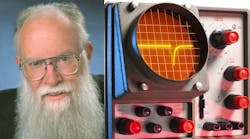Download Volume 3 of the Bob Pease eBook series.
First published September 13, 1990, this is the first of a series of columns about analog and “linear” circuits written by Bob Pease, Staff Scientist at National Semiconductor Corp., Santa Clara, Calif. We think our readers will get a lot out of Bob’s seemingly off-the-wall, yet insightful views of the engineering world.
Why? Why am I going to all the trouble of writing about “linear” and analog circuits? Everybody knows that linear circuits are dead. Nobody’s buying or designing in linear circuits; they are all being replaced by digital signal processors. Analog computers have been dead for years. Why bother?
Well, these days, even though there are tends to perform a lot of functions with digital computations, people are finding that there are still a huge number of things that cannot be done properly without analog circuits. It’s true that some of the trendy new radios claim to use a lot of digital techniques, but even there, the receivers and amplifiers are analog circuits—even if the receiver’s frequency appears to be digitally controlled.
When people are designing digital computers, they need analog techniques to make good layouts for fast buses. They need power supplies—either linear ICs or switch-mode circuits (which use analog circuits internally). And, as for us analog designers, the old-timers and the rookie engineers—well—this column is intended as a soapbox for me to talk about linear circuits, and then for me to listen to your opinions and comments and questions.
I have a lot of opinions, but I’m also very interested in what makes you tick. I may not be the smartest engineer in the whole analog jungle, but I have sort of volunteered to start writing this, and we’ll see what happens—what interesting debates we get into. I have a bunch of opinions about Ics, data sheets, testing, computer simulation, education, troubleshooting, along with a whole slew of little topics.
In every darned issue of Electronic Design, I’ll try to have some provocative or insightful topic. Some will be pretty technical, others will be more philosophical in nature. But one thing’s for sure, I’ll try not to bore you. For example: What’s all this heuristic stuff, anyhow?
HEURISTICS?
The other day I was talking with a young college graduate from a prestigious Eastern engineering school. He explained that his specialty was analog synthesis. I perked up my ears—I hadn’t heard much about that. Where could I read more about this? “Oh,” he said, “in some of the IEEE journals.” Hmm. He started to explain the approach. It’s a heuristic approach, he said. Hmm. What’s a heuristic? He said, “You don’t know what a heuristic is? Really?” I explained no, that we didn’t have any heuristics when I was in school.
(Note: Mr. Webster says that heuristic means “serving to guide, discover, or reveal; specif.: valuable for stimulating or conducting empirical research but unproved or incapable of proof—often used of arguments, methods, or constructs that assume or postulate what remains to be proven or that leads a person to find out for himself.—from the Greek, heuriskein, to discover, find.”)—Gee, that sounds a lot like analysis or optimization to me—not synthesis.
The young man explained that when you make a log of optimization experiments, heuristic refers to the starting place, the initial guess. H’mm. He said, “You feed in some requirements and some specifications, and it optimizes the performance.” Hmm. Now, what circuit does it use? “Oh, it uses the circuit that you give it.” Hmm.
THE KEY QUESTION
If you give it a circuit that doesn’t work well enough, how does it generate a circuit that works better? “Oh, it doesn’t.” I explained to this young fellow, that in our whole product line, about 99% of the circuits are not optimized at all—at least not “optimized” in the sense that he understands. If you really OPTOMIZED them, they would all be a little different than they are now. But each one has a different circuit that is a revolutionary—not just an evolutionary—change from any pervious circuit. So there may be places in our company where optimization is useful and a good idea.
But I wish he couldn’t call it “analog synthesis,” that seems to be a misnomer. The circuits around our area—the ones in the NSC Linear data books (and, I bet, in the PMI and Analog Devices data books, too), where not “synthesized” except by bright engineers who knew that the old circuits wouldn’t cut it, and a new circuit was needed. Good luck, young fellow!
All for now. / Comments invited! / RAP / Robert A. Pease / Engineer

